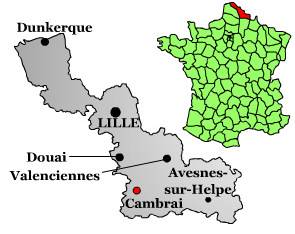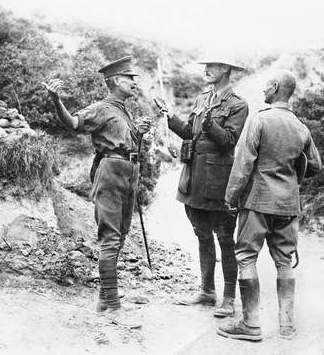|
II ANZAC (XXII Corps) Mounted Regiment
The II ANZAC Corps Mounted Regiment was a combined mounted unit made up of Australian and New Zealand troops during the First World War. The regiment served on the Western Front between 1916 and 1918. For the most part, the regiment undertook rear area duties, although it undertook more mobile operations in early 1917 during the German withdrawal to the Hindenburg Line. In November 1917, the regiment was redesignated as the XXII Corps Mounted Regiment when II ANZAC Corps was converted into XXII Corps. During early 1918, the regiment played a defensive role during the German spring offensive and then supported French operations during the Second Battle of the Marne. The regiment continued operations throughout the remainder of 1918, supporting the Allied Hundred Days Offensive until the end of the war. History The regiment was formed in July 1916 when two Australian squadrons from the 4th Light Horse Regiment were joined together with a New Zealand squadron from the Otago Mou ... [...More Info...] [...Related Items...] OR: [Wikipedia] [Google] [Baidu] |
Australian Army
The Australian Army is the principal Army, land warfare force of Australia, a part of the Australian Defence Force (ADF) along with the Royal Australian Navy and the Royal Australian Air Force. The Army is commanded by the Chief of Army (Australia), Chief of Army (CA), who is subordinate to the Chief of the Defence Force (Australia), Chief of the Defence Force (CDF) who commands the ADF. The CA is also directly responsible to the Minister of Defence (Australia), Minister for Defence, with the Department of Defence (Australia), Department of Defence administering the ADF and the Army. Formed in 1901, as the Commonwealth Military Forces, through the amalgamation of the colonial forces of Australia following the Federation of Australia. Although Australian soldiers have been involved in a number of minor and major conflicts throughout Australia's history, only during the Second World War has Australian territory come under direct attack. The Australian Army was initially composed a ... [...More Info...] [...Related Items...] OR: [Wikipedia] [Google] [Baidu] |
Corps
Corps (; plural ''corps'' ; from French , from the Latin "body") is a term used for several different kinds of organization. A military innovation by Napoleon I, the formation was first named as such in 1805. The size of a corps varies greatly, but from two to five divisions and anywhere from 40,000 to 80,000 are the numbers stated by the US Department of Defense. Within military terminology a corps may be: *an military organization, operational formation, sometimes known as a field corps, which consists of two or more division (military), divisions, such as the I Corps (Grande Armée), , later known as ("First Corps") of Napoleon I's ); *an administrative corps (or Muster (military), mustering) – that is a #Administrative corps, specialized branch of a military service (such as an artillery corps, a medical corps, or a force of military police) or; *in some cases, a distinct service within a national military (such as the United States Marine Corps). These usages often ov ... [...More Info...] [...Related Items...] OR: [Wikipedia] [Google] [Baidu] |
Distinguished Conduct Medal
The Distinguished Conduct Medal was a decoration established in 1854 by Queen Victoria for gallantry in the field by other ranks of the British Army. It is the oldest British award for gallantry and was a second level military decoration, ranking below the Victoria Cross, until it was discontinued in 1993 when it was replaced by the Conspicuous Gallantry Cross. The medal was also awarded to non-commissioned military personnel of other Commonwealth Dominions and Colonies.Veterans Affairs Canada – Distinguished Conduct Medal (DCM) (Access date 19 May 2015) (Access date 19 May 2015) Institution The ...[...More Info...] [...Related Items...] OR: [Wikipedia] [Google] [Baidu] |
Military Cross
The Military Cross (MC) is the third-level (second-level pre-1993) military decoration awarded to officers and (since 1993) other ranks of the British Armed Forces, and formerly awarded to officers of other Commonwealth countries. The MC is granted in recognition of "an act or acts of exemplary gallantry during active operations against the enemy on land" to all members of the British Armed Forces of any rank. In 1979, the Queen approved a proposal that a number of awards, including the Military Cross, could be recommended posthumously. History The award was created on 28 December 1914 for commissioned officers of the substantive rank of captain or below and for warrant officers. The first 98 awards were gazetted on 1 January 1915, to 71 officers, and 27 warrant officers. Although posthumous recommendations for the Military Cross were unavailable until 1979, the first awards included seven posthumous awards, with the word 'deceased' after the name of the recipient, from rec ... [...More Info...] [...Related Items...] OR: [Wikipedia] [Google] [Baidu] |
13th Light Horse Regiment (Australia)
The 13th Light Horse Regiment was a mounted infantry regiment of the Australian Army during the First World War. The regiment was raised in March 1915, and eventually assigned as the mounted regiment for the Australian Corps. During the war the regiment fought against the forces of the Ottoman Empire, at Gallipoli, and against the German Empire on the Western Front. For its role in the war the regiment was awarded twelve battle honours. In 1921, it was later re-raised as a part-time unit of the Citizens Forces, and was briefly amalgamated with the 19th Light Horse. During the Second World War, the regiment was converted into an armoured regiment, designated the "13th Armoured Regiment", although it was disbanded in late 1943 without seeing action. Formation The 13th Light Horse Regiment was raised in Victoria in March 1915. Being the thirteenth regiment raised within the Australian Imperial Force (AIF) they were soon given the nickname the "Devil's Own" regiment, and comprised t ... [...More Info...] [...Related Items...] OR: [Wikipedia] [Google] [Baidu] |
Valenciennes
Valenciennes (, also , , ; nl, label=also Dutch, Valencijn; pcd, Valincyinnes or ; la, Valentianae) is a commune in the Nord department, Hauts-de-France, France. It lies on the Scheldt () river. Although the city and region experienced a steady population decline between 1975 and 1990, it has since rebounded. The 1999 census recorded that the population of the commune of Valenciennes was 41,278, and that of the metropolitan area was 399,677. History Before 1500 Valenciennes is first mentioned in 693 in a legal document written by Clovis II (''Valentiana''). In the 843 Treaty of Verdun, it was made a neutral city between Neustria and the Austrasia. Later in the 9th century the region was overrun by the Normans, and in 881 the town passed to them. In 923 it passed to the Duchy of Lower Lotharingia dependent on the Holy Roman Empire. Once the Empire of the Franks was established, the city began to develop, though the archaeological record has still not revealed all it has to ... [...More Info...] [...Related Items...] OR: [Wikipedia] [Google] [Baidu] |
Cambrai
Cambrai (, ; pcd, Kimbré; nl, Kamerijk), formerly Cambray and historically in English Camerick or Camericke, is a city in the Nord (French department), Nord Departments of France, department and in the Hauts-de-France Regions of France, region of France on the Scheldt river, which is known locally as the Escaut river. A Subprefectures in France, sub-prefecture of the department, Cambrai is a town which had 32,501 inhabitants in 2018. It is in the heart of the urban unit of Cambrai with 46,772 inhabitants. Its functional area (France), functional area, a more extensive range, included 94,576 inhabitants in 2018.Comparateur de territoire: Aire d'attraction des villes 2020 de Cambra ... [...More Info...] [...Related Items...] OR: [Wikipedia] [Google] [Baidu] |
Alexander Godley
General Sir Alexander John Godley, (4 February 1867 – 6 March 1957) was a senior British Army officer. He is best known for his role as commander of the New Zealand Expeditionary Force and II Anzac Corps during the First World War. Born in Gillingham, Kent, in England, Godley joined the British Army in 1886. He fought in the Boer War and afterwards served in a number of staff positions in England. In 1910 he went to New Zealand as Commandant of the New Zealand Military Forces. Promoted to temporary major general, he reorganised the country's military establishment. Following the outbreak of the First World War, the New Zealand government appointed him as commander of the New Zealand Expeditionary Force, which he led for the duration of the war. During the Gallipoli campaign, Godley commanded the composite New Zealand and Australian Division, before taking over command of the Australian and New Zealand Army Corps for the final stages of the campaign. Promoted to lieutenant g ... [...More Info...] [...Related Items...] OR: [Wikipedia] [Google] [Baidu] |
III Corps (United Kingdom)
III Corps was an army corps of the British Army formed in both the First World War and the Second World War. Prior to the First World War In 1876, a mobilisation scheme for eight army corps was published, with '3rd Corps' headquartered at Croydon and composed of the guards regiments. In 1880 its order of battle was: *1st Division (Croydon) **1st Brigade (London) ***1st Bn. Grenadier Guards (Wellington Barracks), 2nd Bn. Coldstream Guards (The Tower), 2nd Bn. Scots Guards (Chelsea) **2nd Brigade (Croydon) ***3rd Bn. Grenadier Guards (Chelsea), 1st Bn. Coldstream Guards (Shorncliffe), 1st Bn. Scots Guards (Wellington Barracks) **Divisional Troops ***1st Bn. 60th Foot (Winchester), Staffordshire Yeomanry (Lichfield), 9th Company Royal Engineers (RE) (Chatham) **Artillery ***C/5th Brigade Royal Artillery(RA) (Ipswich), B/5th Brigade RA (Chatham), B/6th Brigade RA (Woolwich) *2nd Division ( Red Hill) **1st Brigade (Red Hill) ***Kilkenny Militia (Kilkenny), King's County Militia (Pa ... [...More Info...] [...Related Items...] OR: [Wikipedia] [Google] [Baidu] |
Kemmelberg
Kemmelberg (, ) is a hill formation in Flanders, Belgium. It is located less than a kilometer from the village of Kemmel, part of the municipality of Heuvelland in West Flanders. History The earliest settlements on the Kemmelberg date back 2.500 years, when Celts, Celtic tribes of the Hallstatt culture populated the area. The hill takes its name from Camulos, the Celtic god of war. During World War I, it was the location of one of the war's most ferocious battles. Because of its strategic importance, it was fiercely fought in the Battle of the Lys (1918), Fourth Battle of Ypres. On 25 April 1918, German imperial forces, hoping to force a breakthrough to the North Sea, started attacking the French troops on the Kemmelberg with gas grenades. At 6 a.m. the Alpenkorps (German Empire), German Alpenkorps seized and captured the Kemmelberg, causing allied troops to withdraw from all the hills in the region. Thousands of French soldiers were slaughtered. Several streets and army barracks ... [...More Info...] [...Related Items...] OR: [Wikipedia] [Google] [Baidu] |
Australian Corps
The Australian Corps was a World War I army corps that contained all five Australian infantry divisions serving on the Western Front. It was the largest corps fielded by the British Empire in France. At its peak the Australian Corps numbered 109,881 men. By 1918 the headquarters consisted of more than 300 personnel of all ranks, including senior staff officers, as well as supporting personnel such as clerks, drivers and batmen. Formed on 1 November 1917, the corps replaced I Anzac Corps while II Anzac Corps, which contained the New Zealand Division, became the British XXII Corps on 31 December.Becke, p. 258. While its structure varied, Australian Corps usually included 4–5 infantry divisions, corps artillery and heavy artillery, a corps flying squadron and captive balloon sections, anti-aircraft batteries, corps engineers, corps mounted troops (light horse and cyclists), ordnance workshops, medical and dental units, transport, salvage and an employment company. History Follo ... [...More Info...] [...Related Items...] OR: [Wikipedia] [Google] [Baidu] |


.jpg)

